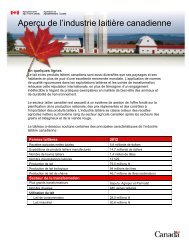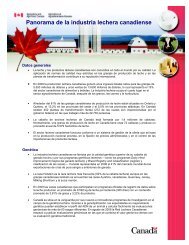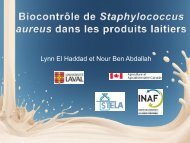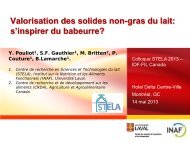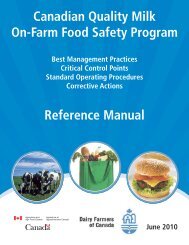Probiotiques dans les produits laitiers - Centre canadien d ...
Probiotiques dans les produits laitiers - Centre canadien d ...
Probiotiques dans les produits laitiers - Centre canadien d ...
Create successful ePaper yourself
Turn your PDF publications into a flip-book with our unique Google optimized e-Paper software.
<strong>Probiotiques</strong> <strong>dans</strong> <strong>les</strong> <strong>produits</strong><br />
<strong>laitiers</strong>: approches récentes en<br />
encapsulation<br />
Claude P. Champagne,<br />
<strong>Centre</strong> de Recherche et de Développement sur <strong>les</strong> Aliments<br />
Saint-Hyacinthe, Québec<br />
STELA<br />
Montréal<br />
2013-05-17
Au menu …<br />
• <strong>Probiotiques</strong>: définition<br />
• Examen de 7 types d’encapsulation<br />
• Produits sur le marché<br />
• Efficacité de l’encapsulation <strong>dans</strong>:<br />
‣ Survie à la congélation<br />
‣ Stabilité durant l’entreposage<br />
‣ Survie à un environment gastro-intestinal<br />
‣ Perspectives futures<br />
<strong>Probiotiques</strong> Technologie Transformation Entreposage Système GI Conclusion
Que sont <strong>les</strong> probiotiques?<br />
<strong>Probiotiques</strong> Technologie Transformation Entreposage Système GI Conclusion
<strong>Probiotiques</strong> sont:<br />
“Microorganismes vivants qui, lorsque<br />
consommés en quantité suffisante,<br />
confèrent un effet santé à l’hôte”<br />
<strong>Probiotiques</strong> Technologie Transformation Entreposage Système GI Conclusion
Technologies d’encapsulation<br />
<strong>Probiotiques</strong> Technologie Transformation Entreposage Système GI Conclusion
Techniques : effet sur la taille des particu<strong>les</strong><br />
Effet sur <strong>les</strong> propriétés sensoriel<strong>les</strong><br />
Burgain et al. (2011).. Journal of Food<br />
Engineering, 104, 467-483.<br />
<strong>Probiotiques</strong> Technologie Transformation Entreposage Système GI Conclusion
<strong>Probiotiques</strong> microencapsulés<br />
To « see »,<br />
or not to « see »?<br />
That is the question.<br />
www.plaisirs<strong>laitiers</strong>.ca<br />
<strong>Probiotiques</strong> Technologie Transformation Entreposage Système GI Conclusion
Avant que je continue …<br />
5th Annual Innovation Report (2003) :<br />
Trading in the Global Ideas Market, par<br />
The Conference Board of Canada<br />
8
Desserts / crème glacée avec particu<strong>les</strong><br />
‣ Chocolat<br />
‣ Noix<br />
‣ Fruits<br />
‣ Bonbons<br />
‣ Biscuits<br />
www.saucysprink<strong>les</strong>.com<br />
www.stuffpoint.com<br />
<strong>Probiotiques</strong> Technologie Transformation Entreposage Système GI Conclusion
Particu<strong>les</strong> <strong>dans</strong> le yogourt<br />
‣ Fruits<br />
‣ Céréa<strong>les</strong><br />
www.nourishfoodlife.com.au<br />
http://www.agroindustriindonesia.blogspot.com<br />
<strong>Probiotiques</strong> Technologie Transformation Entreposage Système GI Conclusion
Fromages avec particularités visib<strong>les</strong><br />
Raclette de Compton (poivre)<br />
Rassembleu<br />
Morbier<br />
St-Antoine<br />
‣ Épices<br />
‣ Herbes<br />
‣ Légumes<br />
‣ Cultures<br />
‣ Cendres<br />
www.fromageriehamel.com<br />
http://fromagesduquebec.qc.ca<br />
<strong>Probiotiques</strong> Technologie Transformation Entreposage Système GI Conclusion
Technologie #1<br />
Bil<strong>les</strong> d’alginate par extrusion<br />
<strong>Probiotiques</strong> Technologie Transformation Entreposage Système GI Conclusion
Bil<strong>les</strong> (et autres formes) d’alginate<br />
<strong>Probiotiques</strong> Technologie Transformation Entreposage Système GI Conclusion
Technologie #1: extrusion de bil<strong>les</strong><br />
www.nisco.ch and www.inotech.ch<br />
<strong>Probiotiques</strong> Technologie Transformation Entreposage Système GI Conclusion
Enrobages multip<strong>les</strong><br />
• Chitosan<br />
• Poly-L-lysine<br />
• Alginate encore<br />
• Huile<br />
<strong>Probiotiques</strong> Technologie Transformation Entreposage Système GI Conclusion
Formes commercialement disponib<strong>les</strong> de<br />
particu<strong>les</strong> d’alginate<br />
Canada<br />
http://www.micropharma.net/<br />
Alginate – poly-L-lysine – Alginate<br />
Belgique<br />
http://www.intelicaps.net/en/home<br />
Alginate … et ?<br />
<strong>Probiotiques</strong> Technologie Transformation Entreposage Système GI Conclusion
Technologie #2<br />
Bil<strong>les</strong> d’alginate par émulsion<br />
<strong>Probiotiques</strong> Technologie Transformation Entreposage Système GI Conclusion
Émulsification<br />
Les taux d’homogénéisation ou d’agitation<br />
contrôlent la taille des particu<strong>les</strong><br />
Burgain et al. (2011).. Journal of Food<br />
Engineering, 104, 467-483.<br />
<strong>Probiotiques</strong> Technologie Transformation Entreposage Système GI Conclusion
Technologie #3<br />
Enrobage sur lit fluidisé<br />
« Spray-coating »<br />
<strong>Probiotiques</strong> Technologie Transformation Entreposage Système GI Conclusion
Technologie #2: Enrobage sur lit fluidisé (ELF)<br />
« Spray coating »<br />
<strong>Probiotiques</strong> Technologie Transformation Entreposage Système GI Conclusion
Enrobage sur lit fluidisé (ELF)<br />
« Spray coating »<br />
www.institut-rosell-lallemand.com<br />
<strong>Probiotiques</strong> Technologie Transformation Entreposage Système GI Conclusion
Effet de ME par ELF sur la taille des particu<strong>les</strong><br />
Poudres par « ELF»<br />
Lactobacillus rhamnosus R0011<br />
Poudre de cellu<strong>les</strong> libres<br />
Lactobacillus rhamnosus R0011<br />
Taile<br />
(µm)<br />
% de poudre récupéré<br />
Libre<br />
ME par ELF<br />
> 500 < 1 4<br />
250-500 8 32<br />
150-250 19 41<br />
90-150 26 21<br />
53-90 25 2<br />
38-53 13
Technologie #4<br />
Séchage par atomisation<br />
« Spray-drying »<br />
<strong>Probiotiques</strong> Technologie Transformation Entreposage Système GI Conclusion
Technologie #3: Séchage par atomisation<br />
(“spray-drying”)<br />
Laboratory-scale spray dryer<br />
A=Solution or suspension to be dried in,<br />
B=Atomization gas in,<br />
1= Drying gas in,<br />
2=Heating of drying gas,<br />
3=Spraying of solution or suspension,<br />
4=Drying chamber,<br />
5=Part between drying chamber and<br />
cyclone,<br />
6=Cyclone,<br />
7=Drying gas is taken away,<br />
8=Collection vessel of product, arrows mean<br />
that this is co-current lab-spray dryer<br />
http://upload.wikimedia.org/wikipedia/commons/thumb/4/4c/Labs<br />
praydryer.svg/388px-Labspraydryer.svg.png<br />
<strong>Probiotiques</strong> Technologie Transformation Entreposage Système GI Conclusion
Séchage par atomisation “Spray-drying”<br />
• Séchage d’émulsions avec<br />
bactéries probiotiques<br />
• Les particu<strong>les</strong> de gras semblent<br />
protéger <strong>les</strong> bactéries<br />
• Des antioxydants sont souvent<br />
ajoutés<br />
• Avantage: faible coût de<br />
production<br />
• Désavantage: Ce ne sont pas<br />
toutes <strong>les</strong> souches qui tolèrent<br />
la chaleur<br />
Ying, et al. (2011). Journal of Agricultural<br />
& Food Chemistry, 59, 10556-10563.<br />
<strong>Probiotiques</strong> Technologie Transformation Entreposage Système GI Conclusion
Disponible commercialement ? Opportunité?<br />
http://pipeline.csiro.au/divisions/food-health-lifesciences/micromax/<br />
<strong>Probiotiques</strong> Technologie Transformation Entreposage Système GI Conclusion
Technologie #5<br />
Particu<strong>les</strong> lipidiques<br />
« Spray-chilling »<br />
<strong>Probiotiques</strong> Technologie Transformation Entreposage Système GI Conclusion
Technologie #5: Mélange avec gras<br />
• Poudre de bactéries probiotiques mélangée avec<br />
base lipidique liquide à 40 o C<br />
• Pompage et injection (35-38 o C) sur plaque froide<br />
• Sur plus petite échelle = spray chilling<br />
Très doux. Industrie<br />
pourrait nécessiter de<br />
plus hautes T o<br />
Pictures of chocolate fromwww.wikipedia.org<br />
<strong>Probiotiques</strong> Technologie Transformation Entreposage Système GI Conclusion
« Spray chilling »<br />
Semblable au séchage par atomisation<br />
• Phase huileuse plutôt que aqueuse<br />
• Air froid plutôt que chaud<br />
Nébulisation<br />
(« nozzle »)<br />
Atomisation par<br />
disque rotatif<br />
http://www.niroinc.com/food_chemical/spray_cooling_congealing.asp<br />
<strong>Probiotiques</strong> Technologie Transformation Entreposage Système GI Conclusion
D’un point de vue éthique, est-ce une bonne idée<br />
d’ajouter des probiotiques au chocolat?<br />
• L’ajout d’« ingrédients santé » (calcium,<br />
antioxydants, probiotiques, ...) à<br />
des aliments hauts en calories est<br />
effectivement “discutable”.<br />
• Cultures probiotiques sont disponib<strong>les</strong><br />
à 100 milliards CFU/g<br />
• Ajouter 10 % au chocolat = 10 milliards CFU/g<br />
• Seulement 1 g chocolat (= 60 calories) surpasse par<br />
un facteur of 10 la dose de 1 milliard de CFU/portion<br />
de l’ACIA Acceptable ????
Produits sur le marché<br />
http://www.barry-callebaut.com/51?release=3864<br />
<strong>Probiotiques</strong> Technologie Transformation Entreposage Système GI Conclusion
http://www.asiakaslehti.com/foodsandfunctionals/node/23<br />
<strong>Probiotiques</strong> Technologie Transformation Entreposage Système GI Conclusion
Désavantage:<br />
petit nombre<br />
http://biogaia.com/product/biogaia-protectis-straw<br />
<strong>Probiotiques</strong> Technologie Transformation Entreposage Système GI Conclusion
Le beurre comme source de lipides pour la ME ?<br />
• Beurre lui-même : NON<br />
‣ Activité de l’eau de 0.9 : trop élevée<br />
‣ Produit ne serait pas assez stable (la<br />
bactérie se retrouverait principalement<br />
<strong>dans</strong> la phase aqueuse)<br />
• Huile de beurre d’où on a enlevé le lait<br />
écréme (phase aqueuse ) … je crois<br />
que OUI<br />
• NB On parle ici d’utiliser la m.g.laitière pour faire de<br />
l’encapsulation … pas d’ajouter des probiotiques au<br />
beurre lui-même.
Technologie #6<br />
Compression<br />
<strong>Probiotiques</strong> Technologie Transformation Entreposage Système GI Conclusion
Compression<br />
Diagramme montrant la compression<br />
d’un concentré bactérien.<br />
Chan, E. S., & Zhang, Z. (2002). Trans IChemE, 80, Part C, 78-82.<br />
<strong>Probiotiques</strong> Technologie Transformation Entreposage Système GI Conclusion
« Lorsque humidifié par <strong>les</strong><br />
fluides gastriques, une<br />
couche protectrice se forme<br />
pour protéger le contenu de<br />
l’acidité gastrique »<br />
http://www.nutraceutix.com/probiotics/biotract.html<br />
<strong>Probiotiques</strong> Technologie Transformation Entreposage Système GI Conclusion
http://biovelia.com/node/29<br />
<strong>Probiotiques</strong> Technologie Transformation Entreposage Système GI Conclusion
Compression et « spray-coating »<br />
‣ Les cultures ME par « spray-coating » ont<br />
une meilleure survie à la compression<br />
‣ Système à double encapsulation<br />
Durand, H., & Panes, J. (2003). Unites States Patent US2003/0109025 A1.<br />
<strong>Probiotiques</strong> Technologie Transformation Entreposage Système GI Conclusion
Technologie #7<br />
Coagulation par présure<br />
<strong>Probiotiques</strong> Technologie Transformation Entreposage Système GI Conclusion
Coagulation à la présure<br />
Burgain et al. (2011).. Journal of Food<br />
Engineering, 104, 467-483.<br />
<strong>Probiotiques</strong> Technologie Transformation Entreposage Système GI Conclusion
Coagulation à la<br />
présure<br />
• Essentiellement une particule<br />
de fromage!<br />
• Au CRDA on lyophilise simplement<br />
un concentré cellulaire<br />
coagulé.<br />
‣ Broyage en fine poudre<br />
‣ Nos travaux: pas d’effet protecteur contre l’acidité ou la<br />
chaleur. Particu<strong>les</strong> trop petites?<br />
• Potentiel : utiliser cette poudre en ELF (« spraycoating<br />
»)? Encapsulation multiple Champagne, Gardner, Britten,<br />
Vuillemard, Unpublished
Bénéfices <strong>dans</strong> <strong>les</strong> aliments<br />
<strong>Probiotiques</strong> Technologie Transformation Entreposage Système GI Conclusion
Encapsulation des probiotiques<br />
To « bead »,<br />
or not to « bead »?<br />
That is the question.<br />
<strong>Probiotiques</strong> Technologie Transformation Entreposage Système GI Conclusion
Bénéfices<br />
1: transformation<br />
<strong>Probiotiques</strong> Technologie Transformation Entreposage Système GI Conclusion
Ajout de probiotiques au chocolat<br />
Température du chocolat = 45 o C<br />
Pertes de viabilité de Lactobacillus rhamnosus durant la<br />
production de la particule de chocolat<br />
Particule de chocolat<br />
Perte CFU<br />
(log 10<br />
/g)<br />
Perte CFU<br />
(%)<br />
Cellu<strong>les</strong> libres 0.20 37<br />
ELF (Spray-coated) 0.16 30<br />
La littérature montre qu’à des T o plus<br />
élevées de chocolat, <strong>les</strong> bénéfices de la<br />
ME par EFL sont plus grands.<br />
Guertin<br />
Raymond<br />
Champagne<br />
Unpublished<br />
<strong>Probiotiques</strong> Technologie Transformation Entreposage Système GI Conclusion
Cultures encapsulées<br />
• Même avec ME : ne pas<br />
s’attendre à une survie<br />
suffisante à la pasteurisation<br />
‣ Seulement de petits stress<br />
thermiques<br />
• Fromage: cuisson à 48-50 o C<br />
• Procédé mozzarella ?
Lait glacé: effet de la taille de la particule<br />
Survie of Lactobacillus delbruecki ssp. bulgaricus<br />
120<br />
100<br />
Dépend de<br />
la souche<br />
Survivants Survivors (%)<br />
80<br />
60<br />
40<br />
20<br />
Free Libre<br />
Small Petite<br />
Medium Médium<br />
Big Grosse<br />
0<br />
0 5 10 15 20 25 30<br />
Temps (jours)<br />
Time (days)<br />
Sheu et al. (1993). Journal of<br />
Dairy Science 76(7): 1902-1907.<br />
<strong>Probiotiques</strong> Technologie Transformation Entreposage Système GI Conclusion
Bil<strong>les</strong> d’alginate<br />
• Permet la diffusion de<br />
molécu<strong>les</strong> de petit poids<br />
moléculaire<br />
• Procure un « microenvironnement<br />
temporaire »<br />
• La plupart du temps … plus <strong>les</strong> bil<strong>les</strong><br />
d’alginate sont grosses, plus el<strong>les</strong> protègent<br />
• Si on utilise de petites bil<strong>les</strong> afin de ne pas<br />
affecter la texture, seront-el<strong>les</strong> encore efficaces?
Bénéfices<br />
2: entreposage<br />
<strong>Probiotiques</strong> Technologie Transformation Entreposage Système GI Conclusion
Entreposage du yogourt<br />
Comptes viab<strong>les</strong> Lactobacillus acidophilus CSCC 2409<br />
État des cellu<strong>les</strong> Période d’entreposage (semaines)<br />
0 2 4 6<br />
Libres 4.6 x 10 8 3.1 x 10 6 4.8 x 10 5 3.3 x 10 4<br />
Alginate seulement 3.5 x 10 8 4.7x 10 7 5.4 x 10 6 2.5 x 10 6<br />
Alginate + chitosan 4.0 x 10 8 5.8 x 10 7 4.2 x 10 7 1.2 x 10 7<br />
Iyer and Kailasapathy (2005) Journal of Food Science 70(1): M18-M23.<br />
<strong>Probiotiques</strong> Technologie Transformation Entreposage Système GI Conclusion
Les bénéfices de la ME en<br />
alginate <strong>dans</strong> le yogourt<br />
État des cellu<strong>les</strong> Période d’entreposage<br />
(semaines)<br />
0 6 ME en alginate fonc-<br />
Alginate + chitosan 4.0 x 10 8 1.2 x 10 7<br />
Libres 4.6 x 10 8 3.3 x 10 4 tionne presque toujours<br />
Alginate seulement 3.5 x 10 8 2.5 x 10 6 … mais pas assez<br />
Canada:<br />
Poly-L-lysine<br />
L’enrobage, ou l’utilisation d’alginate<br />
palmitoylé, améliore presque toujours<br />
la protection … et rend le système<br />
commercialement acceptable.
<strong>Probiotiques</strong> <strong>dans</strong> le fromage Cheddar frais<br />
Effet du pressage des grains de caillé sur la viabilité de<br />
Bifidobacterium longum durant l’entreposage<br />
(●) Grains<br />
(○) Bloc pressé<br />
PAS d’effet de<br />
ME par ELF<br />
Perte en viabilité<br />
Fortin et al (2011) Dairy Sci<br />
Technol. 91: 599-614<br />
Temps (jours)<br />
<strong>Probiotiques</strong> Technologie Transformation Entreposage Système GI Conclusion
<strong>Probiotiques</strong> <strong>dans</strong> le fromage Cheddar frais<br />
Nous avons également mis en évidence<br />
<strong>les</strong> effets d’autres paramètres technologiques<br />
sur <strong>les</strong> CFU:<br />
• Moment de l’inoculation<br />
• Salage<br />
• Taux d’inoculation<br />
Fortin et al (2011) Dairy Sci Technol. 91: 599-614<br />
Fortin,et al (2011) International Dairy Journal 21(2): 75-82.<br />
<strong>Probiotiques</strong> Technologie Transformation Entreposage Système GI Conclusion
Les bénéfices de la ME en fromagerie<br />
• J’ai surtout vu des bénéfices<br />
<strong>dans</strong> <strong>les</strong> fromages frais, pas<br />
<strong>dans</strong> <strong>les</strong> fromages ayant un<br />
long affinage<br />
• Parfois des adaptations<br />
technologiques auront de<br />
meilleurs résultats que la ME<br />
<strong>dans</strong> l’amélioration des CFU<br />
<strong>dans</strong> le fromage.
Entreposage: particu<strong>les</strong> comprimées<br />
<strong>dans</strong> la crème glacée<br />
Viable count (Log CFU g -1 )<br />
Compte viable<br />
9.5<br />
9.0<br />
8.5<br />
8.0<br />
9.5<br />
9.0<br />
8.5<br />
Microencapsulated cells<br />
Free cells<br />
Libre Control<br />
Chocolate<br />
Comprimé Tablet<br />
Effet de l’incorporation de<br />
Lactobacillus rhamnosus<br />
R0011 libre ou ME <strong>dans</strong><br />
le chocolat ou un<br />
comprimé sur sa viabilité<br />
lors de l’entreposage à<br />
-20 o C.<br />
8.0<br />
0 5 10 15 20 25 30<br />
Temps (semaines)<br />
Time (weeks)<br />
Champagne, Raymond,<br />
Bélanger, Guertin.<br />
Unpublished<br />
<strong>Probiotiques</strong> Technologie Transformation Entreposage Système GI Conclusion
Les bénéfices de la ME<br />
• … et … très rarement,<br />
la ME est néfaste<br />
• Raison …<br />
microenvironnements
Particu<strong>les</strong> comprimées<br />
• Effet semble de type « barrière<br />
à la rehydratation »<br />
• Que se passe-t-il lorsque la<br />
particule est ajoutée à un<br />
aliment humide?<br />
‣ Comme l’alginate … le<br />
bénéfice est-il seulement<br />
temporaire?<br />
• Court traitement thermique<br />
• Congélation<br />
• Système GI
Bénéfices<br />
3: gastro-intestinal<br />
<strong>Probiotiques</strong> Technologie Transformation Entreposage Système GI Conclusion
Traitements pour la crème glacée :<br />
encapsulations multip<strong>les</strong><br />
• Libre<br />
• ME par ELF<br />
• Libre <strong>dans</strong> le chocolat<br />
• ME (ELF) <strong>dans</strong> le chocolat<br />
Pictures of chocolate fromwww.wikipedia.org<br />
<strong>Probiotiques</strong> Technologie Transformation Entreposage Système GI Conclusion
Effet de la ME double<br />
Lactobacillus rhamnosus R0011 <strong>dans</strong> la crème glacée<br />
Estomac<br />
Libre<br />
ME par ELF<br />
Libre <strong>dans</strong> chocolat<br />
ME par ELF <strong>dans</strong> chocolat<br />
Temps Time (minutes)<br />
Champagne, Raymond, Mainville, Arcand, Do - Unpublished<br />
<strong>Probiotiques</strong> Technologie Transformation Entreposage Système GI Conclusion
Effet de la ME triple<br />
Compte viable (Log CFU/mL)<br />
Libre<br />
Alginate<br />
AOPL<br />
Temps (minutes)<br />
Ding and Shah (2009) J.<br />
Food Sci. 74(2): M53-M61.<br />
<strong>Probiotiques</strong> Technologie Transformation Entreposage Système GI Conclusion
Conclusion<br />
• Tout d’abord … penser “souche” ou<br />
“adaptation technologique”<br />
‣ Souvent la ME ne fonctionne pas assez<br />
• Plusieurs technologies d’encapsulation<br />
disponib<strong>les</strong><br />
• Seulement quelques probiotiques ME sur le<br />
marché présentement<br />
‣Il faut parler aux fournisseurs pour susciter des innovations<br />
‣Les Canadiens sont des chefs de file mondiaux.<br />
<strong>Probiotiques</strong> Technologie Transformation Entreposage Système GI Conclusion
Conclusion<br />
• Les innovations pourraient<br />
nécessiter des « changements<br />
de paradigmes» en ce qui a trait<br />
à « voir <strong>les</strong> probiotiques ».<br />
• Impact sur <strong>les</strong> propriétés sensoriel<strong>les</strong><br />
• Outil pour différenciation de produit ?<br />
• Tendance vers <strong>les</strong> systèmes<br />
d’encapsulation multiple.<br />
<strong>Probiotiques</strong> Technologie Transformation Entreposage Système GI Conclusion
Conclusion<br />
• Pensée industrielle actuelle: avoir<br />
un CFU donné à la date de<br />
“meilleur avant” !<br />
• ... Pas la fonctionnalité optimale<br />
• Les effets bénéfiques de la ME<br />
pourraient être <strong>les</strong> plus élevés<br />
<strong>dans</strong> le système gastro-intestinal.<br />
‣ ME un outil futur pour <strong>les</strong> étiquettes<br />
“Nouveau et amélioré” ?<br />
<strong>Probiotiques</strong> Technologie Transformation Entreposage Système GI Conclusion
Dans mes rêves …<br />
Un jour, le gouvernement<br />
“ordonnera” l’ajout de probiotiques<br />
<strong>dans</strong> des aliments afin de réduire <strong>les</strong><br />
coûts de santé.<br />
.<br />
La ME sera utilisée pour réduire<br />
l’effet de la matrice alimentaire sur<br />
la fonctionnalité et facilitera<br />
l’obtention d’allégations.<br />
<strong>Probiotiques</strong> Technologie Transformation Entreposage Système GI Conclusion
Merci de votre attention!<br />
Claude P. Champagne, Ph.D.<br />
Chercheur scientifique<br />
Claude.Champagne@agr.gc.ca<br />
450 778-3238<br />
www.agr.gc.ca/Research<strong>Centre</strong>/StHyacinthe
Supplement #1<br />
Some current claims
Probiotics are different from “ active<br />
bacterial cultures ” (starters)<br />
www.yoplait.ca/yoptimal/en/yoptimal_saveurs_zero.aspx#<br />
Probiotics 1. Biscuit 2. Bread 3. Bar Conclusion
Est-ce que<br />
ça marche?<br />
http://www.cyberpresse.ca/vivre/sante/nutrition/201202/14/<br />
01-4495852-la-fin-des-alimentsprobiotiques.php?utm_categorieinterne=trafficdrivers&utm_<br />
contenuinterne=envoyer_cbp
Non-strain associated claims<br />
Eligible bacterial species<br />
Latin name (acceptable nomenclature) and synonym where applicable<br />
Bifidobacterium ado<strong>les</strong>centis<br />
Bifidobacterium animalis subsp. animalis<br />
Bifidobacterium animalis subsp. lactis<br />
- synonyme: B. lactis<br />
Bifidobacterium bifidum<br />
Bifidobacterium breve<br />
Bifidobacterium longum subsp. infantis<br />
Bifidobacterium longum subsp. longum<br />
Lactobacillus acidophilus<br />
Lactobacillus casei<br />
Lactobacillus fermentum<br />
Lactobacillus gasseri<br />
Lactobacillus johnsonii<br />
Lactobacillus paracasei<br />
Lactobacillus plantarum<br />
Lactobacillus rhamnosus<br />
Lactobacillus salivarius<br />
www.inspection.gc.ca/english/fssa/labeti/guide/ch8ae.shtml<br />
Probiotics 1. Biscuit 2. Bread 3. Bar Conclusion
Acceptable non-strain specific<br />
probiotic claim for food<br />
If 1 billion CFU<br />
per portion!<br />
• Probiotic that naturally forms part of the gut flora<br />
• Provides live microorganisms that naturally form part<br />
of the gut flora<br />
• Probiotic that contributes to healthy gut flora<br />
• Provides live microorganisms that contribute to<br />
healthy gut flora<br />
www.inspection.gc.ca/english/fssa/labeti/guide/ch8ae.shtml
Potential strain-specific<br />
claims<br />
No magic number.<br />
You need clinical<br />
trials (and more!).<br />
Improvement of<br />
• Lactose assimilation<br />
• Digestibility of foods<br />
• Immune response<br />
• Blood pressure<br />
• Dental health<br />
Prevention / reduction in symptoms of<br />
• Diarrhea<br />
• Hypercho<strong>les</strong>terolaemia<br />
• Allergies<br />
• Constipation<br />
• Cancer (colon)<br />
• GI tract diseases (overgrowth in the small<br />
intestine, Crohn, irritable colon, colitis)<br />
• Infections in stomach (Helicobacter pylori)<br />
or in urinary system
Aliment<br />
Specific allegations<br />
“The Panel concludes that a cause and effect relationship<br />
has been established between the consumption of live<br />
yoghurt cultures in yoghurt and improved lactose<br />
digestion in individuals with lactose maldigestion.<br />
In order to bear the claim, the yoghurt should contain at<br />
least 10 8 CFU per serving live starter microorganisms (i.e.<br />
Lactobacillus delbrueckii subsp. bulgaricus and<br />
Streptococcus thermophilus). The target population is<br />
individuals with lactose maldigestion”<br />
EFSA (European Food Safety Authority) (2010). EFSA Panel on Dietetic Products, Nutrition and<br />
Allergies (NDA); Scientific Opinion on the substantiation of health claims related to Yoghurt cultures<br />
and improving lactose digestion (ID 1143, 2976) pursuant to Article 13(1) of Regulation (EC) No<br />
1924/2006. EFSA Journal, 8 (10), 1763. Available online: www.efsa.europa.eu/efsajournal.htm.<br />
Allégation
Probiotics: health claims<br />
“ Evaluating the evidence by types of acute diarrhoea<br />
suggests that probiotics significantly reduced:<br />
o antibiotic-associated diarrhoea by 52%<br />
o the risk of travellers’ diarrhoea by 8%<br />
o the risk of acute diarrhoea of diverse causes by<br />
34%<br />
‣ among children by 57%<br />
‣ by 26% among adults”<br />
Sazawal, S., Hiremath, G., Dhingra, U., Malik, P., Deb, S., & Black, R. E. (2006).<br />
Efficacy of probiotics in prevention of acute diarrhoea: a meta-analysis of masked,<br />
randomised, placebo-controlled trials. Lancet Infectious Diseases, 6, 374-382.
Probiotics: health claims<br />
• ProbioKid: “Helps to reinforce the body's natural defences in<br />
children.”(Claim NPN 80019993).<br />
• Probio’Stick: “Helps to reduce stress-related gastrointestinal<br />
complications like nausea.” (Claim NPN 80021343).<br />
• Protecflor: “Helps to reduce the risk of traveler's<br />
diarrhea.”(ClaimNPN 80021342).<br />
• Lacidofil : “Restoring and maintaining intestinal flora”; “Helps to<br />
reduce the risk of antibiotic associated diarrhea AAD (in children<br />
and ado<strong>les</strong>cents from 2 to 18 years of age).” (ClaimNPN<br />
80020017)<br />
• Lalflor (sachets or capsu<strong>les</strong>) (Saccharomyces cerevisiae Boulardii<br />
CNCM I-1079): “Helps to reduce the risk of<br />
• antibiotic associated diarrhea.” (Claim NPN 80038395).
Supplement #2<br />
Benefits
Effet of coatings on particle size<br />
Particle size (µm)<br />
39<br />
37<br />
35<br />
33<br />
Uncoated<br />
alginate<br />
Alginate<br />
Palm oil<br />
Poly-L-Lysine<br />
Ding and Shah (2009) J. Food Sci. 74(2): M53-M61.<br />
<strong>Probiotiques</strong> Technologie Transformation Entreposage Système GI Conclusion
Storage of yoghurt<br />
Krasaekoopt, et al. (2006)." Lebensmittel-Wissenschaft und - Technologie 2006. 39(2): 177-183.<br />
Probiotics Technology Processing Storage GI tract Conclusion
Probiotics in cheese<br />
Also effects of : 1) Moment of inoculation, 2) salting, 3)<br />
inoculation level<br />
Viable counts of Bifidobacterium<br />
longum 15708 in model cheese<br />
throughout<br />
storage (1 day at 22 o C and 20 days at<br />
4 o C). Symbols are:<br />
(●) inoculation in milk/salted curds;<br />
(○) inoculation in milk/unsalted curds;<br />
(▲) inoculation prior to<br />
cheddaring/salted curds;<br />
(▲) inoculation prior to<br />
cheddaring/unsalted curds;<br />
(■) inoculation at 10 X prior to<br />
cheddaring/salted curds;<br />
(□) inoculation at 10 X prior to<br />
cheddaring/unsalted curds.<br />
Fortin et al. (2011). International<br />
Dairy Journal 21(2): 75-82.<br />
Probiotics Technology Processing Storage GI tract Conclusion
Compressed particle in gastric fluid<br />
Effect of<br />
the quantity<br />
of coating<br />
material<br />
At pH 2.0 Free cells = 1.00 E+02 at t = 100 min<br />
Chan, E. S., & Zhang, Z. (2005). Process Biochemistry, 40, 3346-3351<br />
Probiotics Technology Processing Storage GI tract Conclusion






